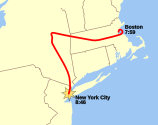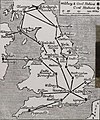Portal:Aviation
| Main page | Categories & Main topics |
|
Tasks and Projects |
The Aviation Portal

Aviation includes the activities surrounding mechanical flight and the aircraft industry. Aircraft includes fixed-wing and rotary-wing types, morphable wings, wing-less lifting bodies, as well as lighter-than-air aircraft such as hot air balloons and airships.
Aviation began in the 18th century with the development of the hot air balloon, an apparatus capable of atmospheric displacement through buoyancy. Some of the most significant advancements in aviation technology came with the controlled gliding flying of Otto Lilienthal in 1896; then a large step in significance came with the construction of the first powered airplane by the Wright brothers in the early 1900s. Since that time, aviation has been technologically revolutionized by the introduction of the jet which permitted a major form of transport throughout the world. (Full article...)
Selected article
The aircraft crashed into the North Tower of the World Trade Center at 08:46 local time; the impact killed all 92 people aboard, including the hijackers. Many people in the streets witnessed the collision, and Jules Naudet captured the impact on video. News agencies began to report on the incident soon after and speculated that the crash had been an accident. The impact and subsequent fire caused the North Tower to collapse, which resulted in thousands of additional casualties. During the recovery effort at the World Trade Center site, workers recovered and identified dozens of remains from Flight 11 victims, but many other body fragments could not be identified. (Full article...)
Selected image
Did you know
...in 1931 Amelia Earhart flew a Pitcairn PCA-2 autogyro to a then world altitude record of 18,415 feet (5613 m)? ...that No. 112 Squadron RAF was the first unit from any air force to use the "Shark Mouth" logo on P-40 fighter planes? ...that during Operation Deep Freeze II in 1956, US Navy Rear Admiral George J. Dufek commanded the first aircraft to land at the South Pole, the C-47 Skytrain “Que Sera Sera”?
General images -
In the news
- May 29: Austrian Airlines cancels Moscow-bound flight after Russia refuses a reroute outside Belarusian airspace
- August 8: Passenger flight crashes upon landing at Calicut airport in India
- June 4: Power firm helicopter strikes cables, crashes near Fairfield, California
- January 29: Former basketball player Kobe Bryant dies in helicopter crash, aged 41
- January 13: Iran admits downing Ukrainian jet, cites 'human error'
- January 10: Fire erupts in parking structure at Sola Airport, Norway
- October 27: US announces restrictions on flying to Cuba
- October 3: World War II era plane crashes in Connecticut, US, killing at least seven
- September 10: Nevada prop plane crash near Las Vegas leaves two dead, three injured
- August 6: French inventor Franky Zapata successfully crosses English Channel on jet-powered hoverboard
Related portals
Associated Wikimedia
The following Wikimedia Foundation sister projects provide more on this subject:
-
Commons
Free media repository -
Wikibooks
Free textbooks and manuals -
Wikidata
Free knowledge base -
Wikinews
Free-content news -
Wikiquote
Collection of quotations -
Wikisource
Free-content library -
Wikiversity
Free learning tools -
Wikivoyage
Free travel guide -
Wiktionary
Dictionary and thesaurus
Selected biography
Jones first saw action as an infantryman in the Gallipoli campaign of 1915, before transferring to the Australian Flying Corps the following year. Initially an air mechanic, he undertook flying training in 1917 and was posted to a fighter squadron in France, achieving seven victories to become an ace. After a short spell in civilian life following World War I, he joined the newly-formed RAAF in 1921, rising steadily through training and personnel commands prior to World War II.
He did not actively seek the position of Chief of the Air Staff before being appointed in 1942, and his conflict with Bostock—with whom he had been friends for 20 years—was partly the result of a divided command structure, which neither man had any direct role in shaping. After World War II Jones had overall responsibility for transforming what was then the world's fourth largest air force into a peacetime service that was also able to meet overseas commitments in Malaya and Korea. Following his retirement from the RAAF he continued to serve in the aircraft industry and later ran unsuccessfully for political office.
Selected Aircraft

The Embraer ERJ-145 is a regional jet produced by Embraer, a Brazilian aerospace company. The ERJ 145 is the largest of a family of airliners, which also includes the ERJ 135, ERJ 140, and Legacy. All aircraft in the series are powered by two turbofan engines. It is one of the most popular regional jet families in the world with primary competition coming from the Canadair Regional Jet.
The first flight of the ERJ 145 was on August 11, 1995, with the first delivery in December 1996 to ExpressJet Airlines (then the regional division of Continental Airlines). ExpressJet is the largest operator of the ERJ 145, with 270 of the nearly 1000 ERJ 145s in service. The second largest operator is American Eagle, with 206 ERJ 145 aircraft. Chautauqua Airlines also operates 95 ERJ 145s through its alliances with American Connection, Delta Connection, US Airways Express and United Express. By some accounts, the ERJ 145 has a cost of ownership of about $2,500,000 per year.
- Span: 20.04 m (65 ft 9 in)
- Length: 29.9 m (98 ft 0 in)
- Height: 6.76 m (22 ft 2 in)
- Engines: 2× Rolls-Royce AE 3007A turbofans, 33.0 kN (7,420 lbf) thrust each
- Cruising Speed: 834 km/h (518 mph, Mach 0.78)
- First Flight: August 11, 1995
- Number built: ≈1000
Today in Aviation
- 2012 – The People's Republic of China conducts its first carrier flight operations with fixed-wing aircraft, when the People's Liberation Army Navy aircraft carrier Liaoning launches and recovers the Shenyang J-15 fighter for the first time.[1]
- 2012 – Two military aircraft OV-10 Bronco collide in the air during a demonstration flight near military El Libertador Air Base in the state of Aragua, Venezuela. One of the pilots is killed, guiding the aircraft away from a populated area. Three soldiers are also injured in the crash.
- 2009 – Italian Air Force Lockheed KC-130 J Hercules MM62176 crashed just after take-off from Galileo Galilei Airport, Pisa. All five crew were killed.
- 2009 – An Aeronautica Militare Italiana Lockheed Martin C-130J Hercules, MM62176, c/n 5497, '46-41', engaged in a training mission crashes on nearby train tracks bordering the Pisa airport, while climbing and performing a left turn immediately after take-off from Galileo Galilei Airport. The aircraft immediately burst into flames, killing its five-member crew.
- 2002 – Launch: Space Shuttle Endeavour STS-113 at 19:38:25 UTC. Mission highlights: ISS assembly flight 11A: P1 truss, crew rotation, last successful mission before STS-107.
- 1978 – Royal Navy Hawker-Siddeley/McDonnell-Douglas F-4K Phantom II FG.1, XT598, used for trials installations at HSA Holme and A&AEE, Boscombe Down, then passed to 111 Squadron. Written off on approach to Leuchars this date.
- 1996 – Ethiopian Airlines Flight 961, a Boeing 767, is hijacked over Kenya. The aircraft runs out of fuel, and the pilot attempts to ditch the aircraft in the ocean off Moroni, Comoros. Of the 175 people on board, 125 were killed (including the 3 hijackers).
- 1989 – An Airbus A310-300 opens Air France’s new direct Lyon/New York service.
- 1985 – EgyptAir Flight 648, a Boeing 737, is hijacked by Palestinian militants. Egyptian special forces storm the plane on the island of Malta. The incident kills 58 out of 90 passengers and all but one of the hijackers.
- 1973 – First flight of the AIDC T-CH-1
- 1973 – Argo 16 was the codename of an Italian Air Force C-47 Dakota aircraft, registration MM61832, used by the Italian Secret Service and the Central Intelligence Agency in covert operations. Officially, those operations were limited to electronic surveillance on the Adriatic Sea and interference with the Yugoslavian radar network. The aircraft crashed on 1973 at Marghera, Italy after an improvised explosive device detonated on board. Venetian Judge Carlo Mastelloni determined that the Argo 16 aircraft was used to shuttle trainees and munitions of NATO members between the military bases around Italy: the aircraft had been involved in unclear operations, as the repatriation of terrorists and transport of secret service agents. The explosion and the subsequent crash killed the four operatives on board.
- 1964 – TWA Flight 800, a Boeing 707, suffers engine failure and crashes at Leonardo da Vinci-Fiumicino Airport, killing 50 of 73 on board; the cause is an inoperative thrust reverser.
- 1962 – United Airlines Flight 297, a Vickers Viscount 745D, crashes near Ellicott City, Maryland, following a bird strike; all 17 people on board died.
- 1961 – Aerolíneas Argentinas Flight 322, a de Havilland Comet 4 DH-106 turbojet, crashes in Campinas, Brazil shortly after takeoff, killing all 12 crew and 40 passengers on board.
- 1959 – First flight of the Boeing 720
- 1953 – USAF pilot 1st Lt. Felix Moncla and radar operator 2nd Lt. Robert L. Wilson take of in a F-89C Scorpion from Kinross Air Force Base, Kincheloe, Michigan investigating an unusual target on radar operators. Wilson had problems tracking the object on the Scorpion's radar, so ground radar operators gave Moncla directions towards the object as he flew. Flying at some 500 miles per hour, Moncla eventually closed in on the object at about 8000 feet in altitude. Ground radar showed both the unidentified craft and the Scorpion suddenly disappearing from screen after intersecting. It is presummed the Scorpion crashed into Lake Superior, though now confirmed traces of the craft or Moncla and Wilson have been found.
- 1949 – Introduction: Convair XC-99
- 1947 – First flight of the Convair XC-99
- 1946 – An Avro Lancastrian powered by two Rolls-Royce Merlin piston engines and two Rolls-Royce Nene turbojets returns from Paris to London in just 41 minutes. The flight from London to Paris was made on November 17. The "Nene Lancastrian" only uses its Merlins for takeoff and landing, becoming the first transport aircraft to fly solely on jet power.
- 1943 – The Deutsche Luftfahrt Sammlung (Berlin Air Museum), at Lehrter Bahnhof, is destroyed in an RAF bombing raid by 383 aircraft:365 Avro Lancaster, 10 Handley Page Halifax, and 8 de Havilland Mosquito bombers. Many exhibited aircraft are destroyed, including the Dornier Do-X, and the Focke-Wulf Cierva C.19a demonstrator, Wrke Nr. 35, D-1960 / D-OBIR. Surviving types are moved E from Berlin where they are discovered post-war. Most of these survivors are now in the Muzeum Lotnictwa Polskiego w Krakowie, the Polish Aviation Museum, at Kraków, Poland.
- 1942 – First flight of the Vought XF5U, dubbed “Flying Flapjack, ” the most radical conventionally-engined aircraft ever built makes its first flight when Chance Vought test pilot, Boone T. Guyton, takes the V-173 into the air.
- 1942 – First flight of the Vought V-173
- 1937 – During the Great Purge, Soviet Air Force commander-in-chief Comandarm Yakov Alksnis is arrested.
- 1934 – First flight of the Bloch MB.210
- 1923 – First of only three Bristol Jupiter Fighters, essentially adaptations of the Bristol F.2B airframe converted with 425 hp (317 kW) Bristol Jupiter IV engines and oleo-type undercarriage, crashes due to an engine seizure at high altitude. Second conversion was sold to Sweden in May 1924, and third was converted to a dual-control trainer.
- 1916 – British ace Lanoe Hawker VC is shot down by Manfred von Richthofen.
References
- ^ Axe, David (November 26, 2012). "China's Aircraft Carrier Successfully Launches Its First Jet Fighters". Wired.co.uk. Retrieved December 2, 2012.
- Shortcuts to this page: Portal:Airplanes • P:AVIA






















































